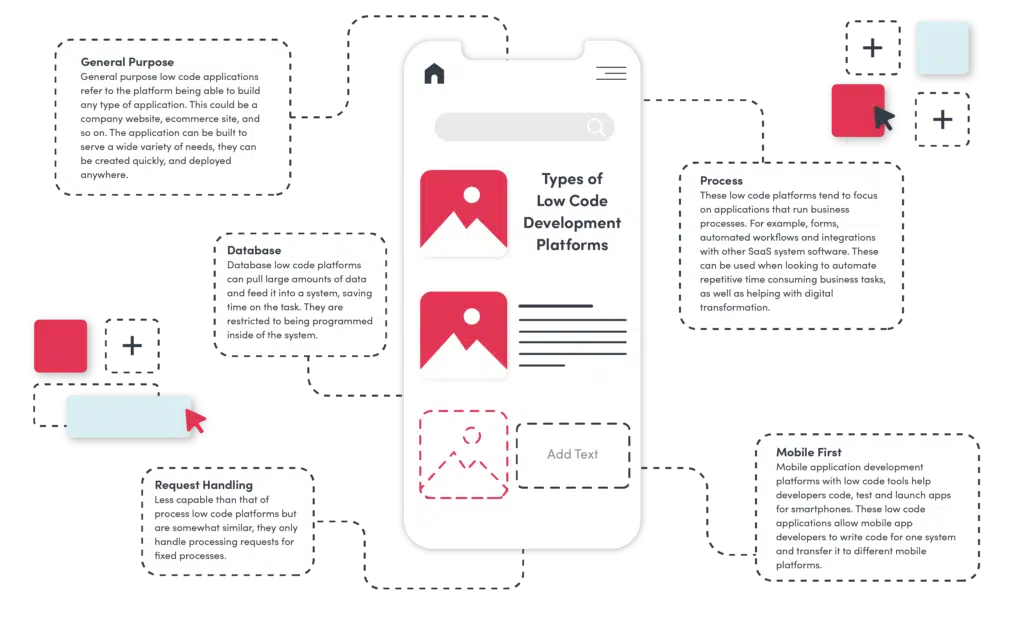New Reasons To Picking Legacy application modernization with Low-code
New Reasons To Picking Legacy application modernization with Low-code
Blog Article
The Benefits Of Low-Code Programming For Application Development As It Is Related To Integration Capabilities
Low-code apps offer a lot of benefits in terms of integration, which is essential when creating applications that can seamlessly connect to different systems and services. Here are some benefits of APIs and connectors that are pre-built:
Connectors that are wide-ranging Low-code platforms include a large library of pre-built connectors for the most popular enterprise systems (e.g. CRM, ERP databases and cloud services). It simplifies the integration with these systems.
API Integration: A lot of low-code platforms have integrated APIs that are built-in that let developers connect easily with external services and sources of data.
Easy to Use:
Integration via Drag and Drop Integration tasks are usually completed using drag and drop interfaces. Developers and non-developers can create complex integrated systems without having to write code.
Visual Workflow Builders: Tools to create workflows and data flows that are visually represented help to learn and configure integrations in a much more simple manner.
Standardized Integration Methods:
SOAP and RESTful Services: Support for standard web service protocols like REST and SOAP allows for easy integration with a range of other software and systems.
OData Standards: OData standards allow for easy manipulation and access of data across different platforms and applications.
Real-Time Data Synchronization:
Real-Time Integrations: Lowcode platforms are able to handle data synchronization in real-time between applications and system to ensure that data is up-to-date and consistent across the organisation.
Event-Driven Architect: A few platforms come with structures that are event driven, allowing applications to respond instantly to events. This is crucial in dynamic interactive applications.
Legacy System Integration:
Interconnecting Old and New Systems Low-code platforms usually include tools for integration with older systems, allowing organizations to upgrade their IT infrastructure without radically overhauling existing systems.
Data Migration: Built-in tools allow you to transfer data from old applications to new ones built on platforms that have low-code.
Integration of Third-Party Services:
Cloud Services Integration: Easy scaling and deployment of applications is possible with seamless integration of cloud services like AWS, Azure and Google Cloud.
Business Applications Integration: Low code platforms can be integrated with various business applications such as Salesforce, SAP and Microsoft Dynamics. This creates a seamless workflow between different business processes.
Simplified Data Management:
Data models that are unifying: Some platforms offer low-code support for unified models of data to facilitate data management across platforms.
Data Connectors: Pre-configured data connectors provide easy access and manipulation of data derived from diverse sources.
Security and Compliance
Secure Integrations - Low-code platforms are designed to ensure that all integrations conform to security protocols and standards. This helps protect information both during its travel and when it's stored.
These platforms are typically equipped with features that help in ensuring compliance (e.g. HIPAA, GDPR) and offer assurance to companies handling sensitive information.
Extensibility:
Custom Codes and scripts. For more complicated requirements in integration, low-code platform usually allows the use of custom code and scripts. This gives flexibility but without compromising user ease.
Plug-in Ecosystem : An ecosystem of plugins and extensions that will enhance integration capabilities through allowing users to add new functionality as required.
Overall, the low-code platform's capabilities for integration can be a very effective tool to create interconnected applications that are efficient and scalable. These platforms facilitate the process of connecting disparate IT systems, improve the flow of information, and assist businesses to adopt the latest technologies as well as leveraging new technologies. Check out the top rated Low-code Platform for application development for blog tips including ms azure sql, azure sql server, develop web app, mobile development platforms, app platforms, develop mobile application, cross platform mobile development, application modernization, mobile development platforms, driver jdbc and more.
Benefits Of Low-Code Application Development In Terms Of Cost-Effectiveness
Low-code development can bring many benefits in terms of cost-effectiveness. This is a great option for companies who want to reduce their development budgets while still providing top quality software. The following are some key advantages.
Lower Coding Requirement: Low programming platforms eliminate the need to write code manually, saving developers both time as well as money. The result is lower labour costs.
Fewer Developer Resources: Since low-code development is faster and easier, fewer developers are needed. This can cut down on the costs of staffing and hiring.
Faster Time to Market
Accelerated development cycle Visual development tools as well as prebuilt components that are provided by low-code platforms allow rapid application development. This allows companies to bring their products to go to market faster. This can result faster revenue generation, and improved standing in the market.
Rapid prototyping. Businesses can test quickly and develop prototypes. This cuts down time in the development process and allows for rapid iterations dependent on the feedback of users.
Lower maintenance costs:
Due to their modularity and standard components, applications built on low-code platforms are easier to maintain. This reduces the cost of ongoing maintenance.
Automated Updates: Many low-code software platforms manage patches and updates in a way that is automatic and ensure that applications are secure and up-to date without needing large manual intervention.
Efficient Resource Utilization:
Non-Developer Contributions: Low-code platforms allow businesses and other non-developers to take part in the development process. This allows employees and employers to cooperate, and reduces dependence on developers who earn high salaries.
Optimized IT Resource Use: IT departments will be able focus on strategic projects, rather than being buried in routine tasks of development. This will boost the overall efficiency and productivity.
Scalable Pricing Models
Subscription Pricing: Many platforms that use low-code provide flexible pricing models that are based on subscriptions that are scaled in accordance with the usage. This allows businesses to be able to align their spending to the actual requirements and expansion, while avoiding huge upfront cost.
Pay-as-you-go Options Certain platforms offer pay-as you-go options that ensure that businesses pay only for the resources they use and can be especially beneficial for startups and small companies with a limited budget.
Costs for reduced Third-Party Software:
Low-code platforms come with built-in integrations and functionalities, which could reduce the cost of subscriptions to software and licensing.
Integrations pre-built: These pre-built systems and services can be integrated with well-known services, reducing the need for custom-built software and saves both time and cost.
Improved ROI:
Faster Return On Investment: A combination of rapid development and lower costs, coupled with speedier time to market allows businesses to get a more return on their investment.
Improved Agility - Companies are able to swiftly adapt to changes in the market and changing customer needs. This allows them stay relevant and capitalize on opportunities that arise.
Low-cost Training:
User-Friendly Interfaces: The nimble, user-friendly interfaces of low-code platforms cut down on the learning curve for novice users, and reduce the requirement for lengthy training programs.
Accessible resources Low-code platforms often have extensive tutorials, training materials, and community assistance, reducing the requirement for formal instruction.
Collaboration is made easier:
Improved Collaboration Tools: Inbuilt collaboration tools aid in better coordination and communication between team members, leading to more efficient development processes and a reduction in project costs.
Unified Development Environment : A unified environment makes work easier and cuts down on the expenses that are associated with managing different platforms and tools.
The overall cost-effectiveness of low-code development comes in its ability to lower maintenance and development costs as well as speed up time to market, optimize resource utilization, and provide flexibility in pricing. Low-code can provide significant financial benefits to businesses. Take a look at the best Legacy application modernization with Low-code for blog advice including application modernization software, push alerts, push alerts, push notifications, app platforms, cloud software applications, azure sql databases, application modernization, azure sql databases, azure sql and more.
The Benefits Of Low-Code Development For Workflow And Collaboration
It's a great option for companies that wish to increase team productivity as well as streamline processes and enhance collaboration. These are the major benefits.
Unified Development Environment Low-code platform provides a single unified environment, where all employees such as analysts, developers design, stakeholders, and more, can efficiently work together. This eliminates silos, and improves communication.
Visual Development Tools: The graphic drag-and-drop feature of low-code platforms makes it easier for non-technical team members take part in the development process, ensuring that business requirements are accurately recorded and implemented.
Communication Improved:
Real-Time Co-operation: A lot of platforms that use low-code support real-time co-operation capabilities like commenting, editing in parallel and getting immediate feedback. They allow for continuous communication by reducing the time needed for back-and-forth discussion.
Shared Workspaces Teams are able to work together using shared workspaces. These workspaces allow them to review, edit and collaborate on elements of the project.
Streamlined Workflow
Built-in project management tools Lowcode platforms usually come equipped with integrated tools that aid teams in planning, tracking, and managing their development. This includes task assignments, progress tracking, and deadline management.
Workflow automation: The automation of routine work, workflows, and other processes minimizes the manual effort required and also eliminates errors. This lets teams concentrate on tasks that are more profitable and boosts efficiency.
Faster Iteration cycles
Rapid Prototyping Low-code platforms are perfect for rapid prototyping. Iterative development is also possible, allowing the team to develop, test and refine their software within shorter time. This allows feedback to be rapidly incorporated, and improvements can be made.
Agile Development Support Agile Development Support: Support for agile methods lets teams work in sprints, continually providing small amounts of functionality and making it easier to respond to evolving requirements.
Accessibility for non-developers
Citizen-driven development platforms permit business users to modify and create applications with no programming expertise. This eases the burden of IT and development departments and lets them respond faster to the needs of business.
Training and Onboarding. The user-friendly interfaces of training tools allow new members to be familiar with the system, and this helps improve teamwork.
Centralized Documentation and Knowledge Sharing
Documentation is integrated: Low-code platforms usually come with the tools needed to create and maintain documentation within the platform, making it simple for all project information to be centralized.
Knowledge Repositories. Teams can set up repositories for knowledge, including templates and parts that can be reused. This will facilitate sharing of knowledge and will reduce duplicate work.
Consistency in Standardization:
Standardized Components - The use of already-built, standardized components gives an enduring consistency across the different applications. It makes it simpler for team members to understand different parts of a given project and work on them.
Governance and compliance Governance and compliance: Integrated governance frameworks ensure that development adheres to the requirements of regulatory standards and organizational standards. This lowers the risk of non-compliance, as well as helping applications meet quality standards.
Feedback and Improvement Loops
Integrated Feedback Low-code platforms offer users with integrated feedback mechanisms which allow them to give users with feedback quickly on their applications. Feedback from users can later integrated into the application development process.
Continuous Improvement: The capability to quickly iterate and implement changes based on feedback assures the continuous improvement of apps that are in line to the requirements of the users and business objectives.
Visualization of Reporting:
Real-time Analytics: Built-in analysis and reporting provides real-time insights into the performance of your project, user interactions and progress. Data-driven decision-making is possible.
Visual Workflow mapping: Visual tools to map workflows can be used by teams to enhance workflows. This helps them identify the bottlenecks, as well as areas of improvement.
In terms of collaboration, low-code apps are ideal for reducing workflows, bring diverse teams together and streamline tasks. This creates a more collaborative, efficient, and agile development environment, ultimately leading to more effective applications and better alignment with business objectives.